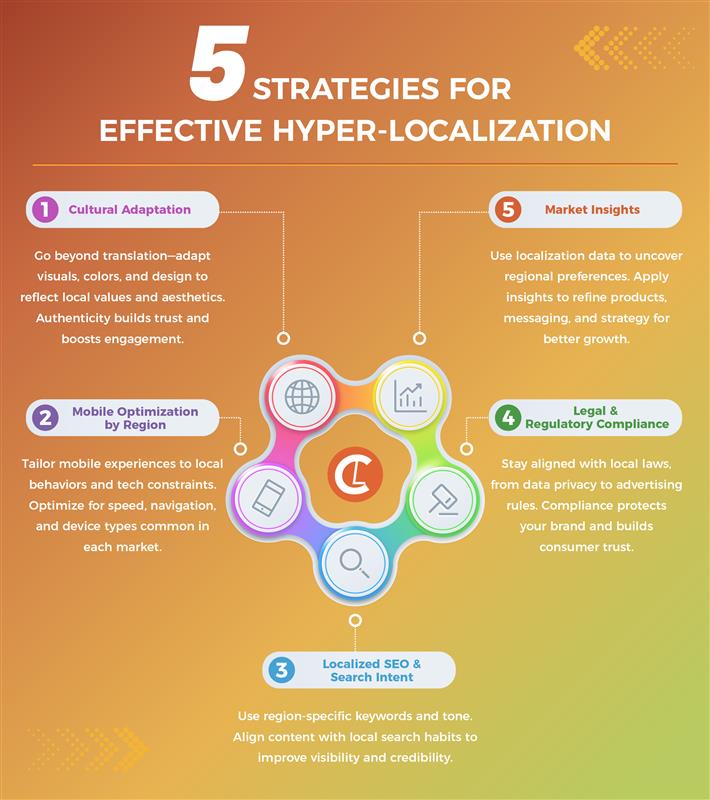Hyper-localization is emerging as an effective approach by emphasizing regional relevance, cultural fluency and personalized engagement.
As global business strategies become more audience-focused, hyper-localization is redrawing the map for how brands connect across borders.
The shift from globalization to hyper-localization marks a major turning point in international business strategy. For decades, globalization emphasized standardization: products, campaigns, and messaging built for mass international appeal. But this model is giving way to more finely tuned strategies. Today, businesses are embracing hyper-localization: the practice of adapting content, design, and communication styles to specific regions, cities, and even neighborhoods.
Hyper-localization involves tailoring user experience to reflect cultural values, local humor, regional slang, legal norms, and even design aesthetics. It spans localized SEO, mobile behavior preferences, visual storytelling, and real-time customer support. AI and large language models (LLMs) have helped scale this effort, but the approach relies just as much on human insight and market-specific expertise.
Andrea Tabacchi, Chief Customer Officer at Phrase, illustrates this shift in his article for Multilingual Magazine, explaining how AI-powered tools can now generate multiple campaign variations by analyzing demographic data, cultural nuances, and behavioral insights. For example, a brand targeting both 20- and 40-year-olds in Milan can use LLMs to create distinct, relevant messaging for each group, abandoning the outdated “global average” in favor of cultural specificity.
Phrase’s Auto Adapt feature takes this a step further, automatically transforming master content into culturally and linguistically localized variants. It ensures tone, style, and references feel native to the target audience, while maintaining brand consistency at scale. This kind of automation makes hyper-localization both scalable and sustainable, even for companies without massive localization teams.
What was once the domain of deep-pocketed multinational corporations is now within reach for companies of all sizes. Hyper-localization has become more than a marketing trend; it’s a strategic necessity. As the limitations of traditional globalization become increasingly clear, organizations are recognizing the need for native-level experiences that connect on a personal and cultural level. Enabled by technology, this new approach to localization is fast becoming a powerful engine for global growth and customer engagement.
Why Hyper-Localization Matters Today
Hyper-localization has become essential in today’s global marketplace for several compelling reasons, many of which are backed by recent research. At the forefront is its ability to boost customer engagement. By delivering personalized, culturally relevant content, businesses can increase conversion rates and foster deeper brand loyalty. As Tabacchi points out, hyper-localization also enables companies to scale their campaigns efficiently, reaching diverse audiences without the steep costs typically associated with mass customization. This translates into a competitive edge, as brands that connect meaningfully with local consumers are more likely to stand out and succeed.
Language preference plays a pivotal role in this equation. According to a Nimdzi report, a striking 7 out of 10 users prefer to browse online in their native language. For companies, this means that effective localization can potentially double their addressable market. Moreover, with non-English-speaking regions projected to represent nearly 5 billion consumers by 2030, businesses that continue relying solely on English content risk missing out on substantial growth opportunities.
Beyond reach and engagement, hyper-localization builds trust. When a brand demonstrates an authentic understanding of local culture, values, and behaviors, it signals respect—and earns credibility. A great example is Canva, which tailored its product messaging in Japan by emphasizing features like its premium font library and background remover tool, elements deeply valued in Japanese design culture. This culturally attuned approach helped Canva resonate with local users and strengthened its brand presence.
In crowded, competitive markets, this cultural fluency can be the difference between a brand that gets ignored and one that becomes a household name. Simply put, hyper-localization is a strategic imperative for businesses looking to thrive in an increasingly diverse global economy.
Common Pitfalls of One-Size-Fits-All Localization
Adopting a blanket localization strategy can backfire spectacularly. Assuming a single translation or creative treatment will resonate everywhere ignores the legal, cultural, and behavioral differences that define each market.
- Cultural Blind Spots
Skipping local norms—whether it’s etiquette, humor, or regulatory quirks—instantly erodes trust. A simple calendar mismatch (lunar vs. Gregorian) or the wrong transit term (“tube” vs. “metro”) can make content feel foreign, even tone-deaf. In highly regulated industries, overlooking country specific compliance wording does more than annoy users; it invites legal trouble.
- Design & UX Misfires
Colors, imagery, and layout conventions vary dramatically. A palette that signals prosperity in one culture might signify mourning in another. Right-to-left scripts, local currencies, and date formats aren’t cosmetic extras; they’re usability essentials. When they’re absent, users abandon the experience—or the brand.
- Language Nuance Gaps
Dialects, slang, and regional phrasing give language its heartbeat. Relying on a single “global” version of Spanish, Arabic, or English turns lively copy into generic mush, undermining authenticity and engagement.
The cost of these oversights is twofold: missed revenue from alienated audiences and long-term damage to brand credibility. In short, a one-size-fits-all approach isn’t just inefficient—it’s risky.

Ready to Localize Smarter?
Hyper-localization is a strategic must for any brand looking to compete and grow in today’s diverse global landscape. Whether you’re just beginning your localization journey or looking to scale your efforts with relevance, Clearly Local is here to help.
Our expert team combines cultural insight, linguistic expertise, and the latest in AI-driven localization tools to ensure your message lands exactly where and when it should. From multilingual content creation to end-to-end localization strategy, we partner with you to turn global goals into local wins.
Reach out to Clearly Local today to learn how we can tailor your content for every market that matters.



